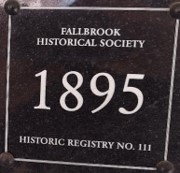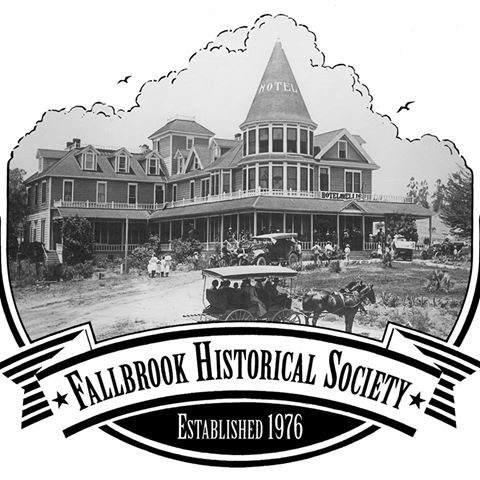

The land on which this small farmhouse sits is rich with Fallbrook history. It was originally part of the Rancho Santa Margarita Land Grant owned by Mexican Governor Pio Pico. In 1848, according to the Treaty of Guadalupe-Hidalgo, which ended the Mexican American War, it was transferred to the United States government, pending completion of land surveys and verification of borders. As a result of the surveys, this strip of land was opened up to homesteading, and title to 80 acres was granted to a young Millard Neff in 1883. In 1885 Neff sold his homestead and between 1885 and 1890 the property changed hands three times. In 1890 the Reverend William Pittenger purchased 20 acres of Neff’s property. On the property he planted a garden, as well as fruit and nuts for both profit and personal use, and employed his neighbor, G.F. Van Velzer, to care for the property. In 1895 he built the little farmhouse. That was the same year that his daughter Harriet married, and she and her husband became managers of the farm.
As a young man William Pittenger was a decorated Civil War hero, having been awarded one of the first Congressional Medals of Honor for his participation in a secret Union army band called “Andrews Raiders”. Their mission was to infiltrate enemy territory, commandeer a confederate train, and to destroy transportation and communication links between Atlanta and Chattanooga. Pittenger wrote his personal account of this failed mission, originally published as Daring and Suffering and later as The Great Locomotive Chase. Two different movie versions were produced, including a Walt Disney version featuring actor Fess Parker.
Apart from being a bona fide war hero, the Reverend Pittenger also became a prominent citizen of Fallbrook. He was minister of the Fallbrook Methodist-Episcopal Church from 1893 to 1896 and again from 1898 to 1899. Additionally, he was an instrumental organizer of the Fallbrook High School District and president of the local school board. He also petitioned state legislators to create the Fallbrook Irrigation District.
Reverend Pittenger died in 1904 and is buried in the Fallbrook Odd Fellows Cemetery. His widow Winnie, sold the property in 1910 and moved back to her residence in Fallbrook, near the church. She was active in the local Women’s Christian Temperance Union, and worked for women’s suffrage and war relief activities as well as organizing the local Red Cross. Mrs. Pittenger died in 1931 and is buried next to her husband.
Between 1910 and 1918 the property changed hands several times. In 1918, B.C. Davies, a Los Angeles doctor, purchased the property. Dr. Davies reportedly conducted a medical practice in an enclosed area on the north porch. Dr. Davies also became a prominent citizen of Fallbrook, serving on the Board of the Fallbrook Irrigation District and organizing the Rotary Club in Fallbrook. Dr. And Mrs. Davies held the property until 1945, when it was passed to family heirs, Edward and Phyllis Brick and Doris Mundhenk. The property was sold in 1946 to John and Marion Griffin who raised two daughters, Molly and Katie, while living in the house. It became known as the Rocky Crest Ranch while owned by the Griffins.
In 1981 the Griffin heirs sold 2 1/2 acres, including the farm house, to the Fallbrook Historical Society. It was used as the original museum until the current building was built in 1993.
Today the Pittenger House is meticulously furnished to reflect the early twentieth century. In the parlor, an authentic Civil War Uniform, much as Sergeant Pittenger would have worn, is proudly displayed, along with an authentic 1890 GAR Medal. You will also see a pump organ and a phonograph along with other vintage artifacts. The bedroom is furnished with an original rope bed, a child’s trundle bed and a cradle, as well as other appropriate artifacts and furnishings. Not to be missed in the bedroom is a popular Victorian work of art, a framed hair picture or “memorial”. The dining room is staged to include two areas; a family corner with a treadle sewing machine and a small sewing chair, and a cabinet with books and games for the children. Many interesting items from the period can be seen in the typically furnished dining area. The kitchen boasts a wood burning stove, an ice box and an authentic Hoosier Cabinet.
The Pittenger House may well be the crown jewel of the Fallbrook Heritage Center, and is the product of considerable restoration under the direction of the Fallbrook Historical Society, and made possible through the generous donations and diligence of many people dedicated to preserving this historic house.
The Pittenger House is a genuine treasure of the Fallbrook Heritage Center.
View the CBS 8 News video about William Pittenger
Take a Virtual Tour of The Pittenger House
